 The battle between buying audiences and buying context is over.
The battle between buying audiences and buying context is over.
Glossy, splashy magazine brands know they’ve lost the cheap CPM game to Facebook, Instagram and Google.
But they’ve regrouped in recent years, figuring out how to connect with advertisers and consumers and shore up revenue by diversifying away from advertising.
At Tuesday’s American Magazine Media Conference in New York City, the heads of Meredith, Hearst, Bonnier, New York Media and Trusted Media Brands (Condé Nast was absent from the panel for the first time in recent years) shared the four things they’re thinking about to make their brands flourish in a rapidly changing media climate.
Magazines are switching to ‘performance’ as advertisers devalue context
Advertisers want performance, not premium context. Magazines can’t fall back on being upper-funnel or brand advertising vehicles anymore.
“We have to convince people that we are performant and be part of an ecosystem increasingly dictated by data and performance,” said Troy Young, who was promoted last year to president of Hearst Magazines from his role as head of digital.
The magazine executives expressed frustration that advertisers say they want brand safety, but aren’t removing their dollars from controversial platforms, such as Facebook.
“[Facebook is] up 30% in advertising, and from a PR and brand safety perspective, they probably had the worst six months in their company’s history,” said Meredith President and CEO Tom Harty. “We wish more advertisers were worried about that, but they’re talking about cheaper CPMs.”
Magazines are watching the influencer trend
Instead of taking beauty and fashion tips from Cosmo or Glamour, readers now follow influencers they trust for inspiration and tips. Increasingly, those influencers capture brands’ advertising budgets. Where does that leave magazine media?
“We are the original influencer,” said Bonnie Kintzer, president and CEO of Trusted Media Brands, which was founded in 1922 as the Readers Digest Association. “That’s a powerful thought to take back to our people.”
Magazine brands will have to think about how to preserve their status as the top authority in an area where readers often value personal opinions and recommendations more than impartial, authoritative knowledge.
“When I go around the world, the No. 1 question is, ‘What are we going to do about influencers?’” Hearst’s Young said. “What people are gravitating toward is a human connection. It puts a lot of pressure on magazine media. We think about creating content, not creating talent.”
Magazines think of their brands first, and media second
To diversify, magazines want to use their brands not only to create content, but to sell products. Meredith will sell $2.8 billion in Better Homes & Gardens merchandise through Walmart this year, Harty said. Readers buy their sheets and towels because they trust the 75-year-old brand.
When Eric Zinczenko was named CEO of Bonnier in 2015, he proposed that a third of its revenue come from print, a third from digital and a third from “everything else,” as part of a plan to “future-proof” Bonnier.
“If it makes money, it makes sense,” Zinczenko said. “We will consider any opportunity that is rooted in some financial sensibility. It’s dangerous for us in media to think we should stay in our swim lane. We are not going to get out of media, but we’re attached to it.”
Magazines are putting up paywalls
New York Media is 10 weeks into adding a paywall. The magazine predicts readers will subscribe in part because of their connection to its brands. “The authority that publishing brands have built with their audiences lends itself to revenue diversification opportunities,” said New York Media CEO Pamela Wasserstein.
Hearst just put up a paywall for Bazaar Bride on Tuesday – an experiment for the small brand, according to Young.
Brands implementing digital paywalls face one huge challenge: They haven’t historically focused on creating great consumer experiences for subscriptions. Instead, they punted to consumer marketing teams, which increased subscriptions with “superficial transactions” designed to increase a rate base with advertisers, not a lasting direct-to-consumer subscription relationship.
For paywalls to work, publishers must get better at relationship and experience management. That may include focusing on how to use their media brands to solve problems for consumers, Young said: “We have to be more thoughtful, research-oriented and data-driven.”
This post was syndicated from Ad Exchanger.


More Stories
Daily Wire Welcomes Perplexity to Advertise on The Ben Shapiro Show
Here’s the Roundup for the Week Ending March 7
Aflac’s Dan Amos Reveals How He’s Successfully Held Onto the CEO’s Job for 35 Years